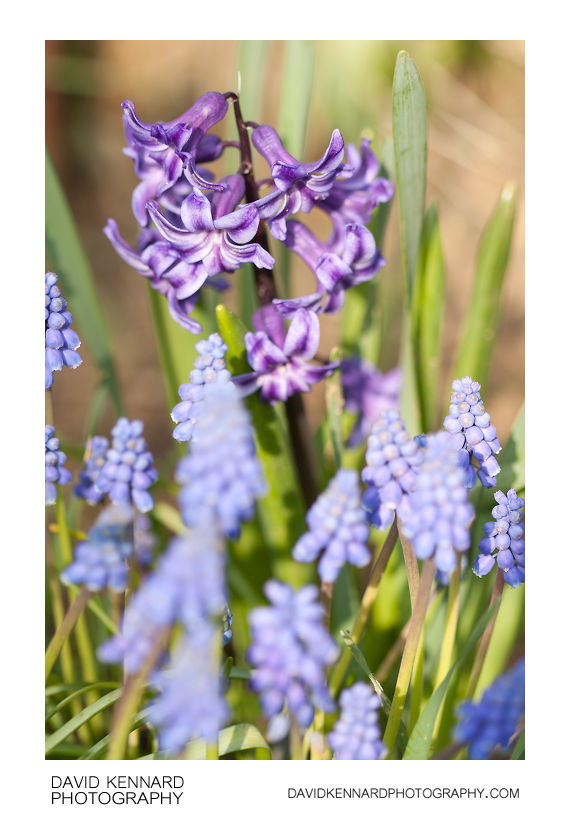Common Hyacinth (Hyacinthus orientalis) and Grape Hyacinth (Muscari sp.)

Description
- Title:
- Common Hyacinth (Hyacinthus orientalis) and Grape Hyacinth (Muscari sp.)
- Caption / Description:
-
Common Hyacinth and Grape Hyacinth, flowering in a garden in late March.
Description of Common Hyacinth from Wikipedia (http://en.wikipedia.org/wiki/Hyacinthus_orientalis):
Hyacinthus orientalis (Common Hyacinth, Garden Hyacinth or Dutch Hyacinth), is a perennial flowering plant of the genus Hyacinthus, native to southwestern Asia, in southern and central Turkey, northwestern Syria, Lebanon and northern Israel. It was introduced to Europe in the 16th century.
It has a long history of cultivation as an ornamental plant, grown across the Mediterranean region, and later France (where it is used in perfumery), the Netherlands (a major centre of cultivation) and elsewhere.
The Garden Hyacinth flowers in the early spring. They grow best in full sun to part shade in well-drained, but not dry, soil. It requires a winter dormancy period, and will only persist in cold-weather regions. It is grown for the clusters of fragrant, brightly-coloured flowers. Over 2,000 cultivars have been selected and named, with flower colour varying from blue, white, pale yellow, pink, red or purple; most cultivars have also been selected for denser flower spikes than the wild type, bearing 40-100 or more flowers on each spike.
Description of Grape Hyacinth from Wikipedia (http://en.wikipedia.org/wiki/Muscari):
The genus Muscari, commonly and collectively known as grape hyacinths, are a group of perennial plants native to Eurasia that produce spikes of dense, most commonly blue, urn-shaped flowers resembling bunches of grapes in the spring. White cultivars also exist.
The Muscari have originated in the old world, from the Mediterranean basin, the Center and South of Europe, Northern Africa, the West, Center and South-West of Asia. The term muscari comes from the Latin muscus, since the scent is said to resemble musk.
- Tags / Keywords:
-
- Biota
- Life
- Vitae
- Eukaryota
- Purple
- Plantae
- Plants
- Magnoliophyta
- Flowering Plants
- Angiosperms
- Liliopsida
- Monocotyledons
- Asparagales
- Hyacinthaceae
- Hyacinthus
- Hyacinthus orientalis
- Common Hyacinth
- Garden Hyacinth
- Dutch Hyacinth
- Muscari
- Grape Hyacinth
Admin
- Date Original Photo Taken:
- Original File Name:
- _MG_6014.CR2
- Event:
- Rating:
- ☆
- Date this image added/last updated on website:
- Original File Dimensions:
- 2848px x 4272px
- File Type:
- JPEG
- Color Mode:
- RGB
- Original Image Color Profile:
- Adobe RGB (1998)
Location
- Location Created:
-
- Sublocation:
- City:
- Market Harborough
- Province/State:
- Leicestershire
- Country:
- United Kingdom
- World Region:
- Europe
- Geo-location:
Rights
- Copyright Status:
- Copyrighted
- Licensing Status:
- Rights Managed
- Available for Editorial Use:
- Yes
- Available for Commercial Use:
- Yes
- Copyright Notice:
- © 2011 Dave Kennard
Camera Data
- Date Digital Resource was created:
- Shutter speed:
- 1⁄320 s
- Aperture:
- f/2.8
- Camera Model:
- Canon EOS 450D
- ISO:
- 100
- Exposure Compensation:
- 0
- Focal Length:
- 100mm
- Focal Length (35mm equiv.):
- Metering Mode:
- Center-weighted average
- Flash:
- Off, Did not fire
- Exposure Mode:
- Manual
- White Balance:
- Manual
- Light Source:
- Exposure Program:
- Manual
Additional shooting metadata
- Lens:
- Canon EF 100mm F2.8 Macro USM
- Filters used:
- Additional Optics used:
- Setup:
- Handheld
Post Processing
- Image Modified:
- Software used:
-
- Adobe Camera RAW
- Post Processing:
-0.15 exposure compensation in ACR
